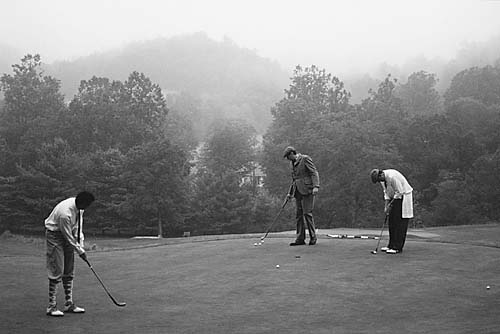Oakhurst Links
Golfing the Old-Time Way
By David Cottrill

Golfers in period dress enjoy the game as it was played in the
1880's at Oakhurst Links near White Sulphur Springs, Greenbrier
County. Photograph courtesy of Oakhurst Links.
Golfers with a keen interest in history can come to Greenbrier County and step back in time. At Oakhurst Links near White Sulphur Springs, they can play the game just the way it was played in the 1880’s.
They can leave their clubs, balls, tees, and bag in the car; they won’t be using them. Martha Asbury, the course historian, provides visitors with replicas of the era’s wooden clubs along with a couple of “gutties” — balls made of gutta-percha, a substance derived from the sap of the Asian sapodilla tree. Golf bags and wooden tees were yet to be invented in the 1880’s, so golfers carry a clutch of four or five clubs in their hand and fashion “tees” from sand and water found in buckets placed at each tee box.
If they dress in period costume, as players sometimes do, and if the secluded parking lot with its modern vehicles is out of view, players could well imagine themselves in a 19th century match.
Martha Asbury explains to guests the rules for 1884 match play. You have to play your lie no matter how bad it is. You have to play around or over your opponent’s ball if it lies between your ball and the cup. If you lose your ball, you’re out of contention for the hole, and you must wait for the next tee to drop a new ball. If your ball breaks, as gutties sometimes do, you can play the largest piece until you hole out. Only then can you bring out a new ball.
About
four-dozen sheep wander about the course, keeping the fairways
“mowed” — a touch of 19th century authenticity.
If a ball lands in sheep castings, you’re entitled to a free
drop. If you hit a sheep, you’re assessed a penalty stroke.
Martha says that hitting a sheep happens about once every
season.
Four gentlemen farmers with roots in Scotland created the course in
1884.
You can read the rest of this article in this issue of Goldenseal, available in bookstores, libraries or direct from Goldenseal.